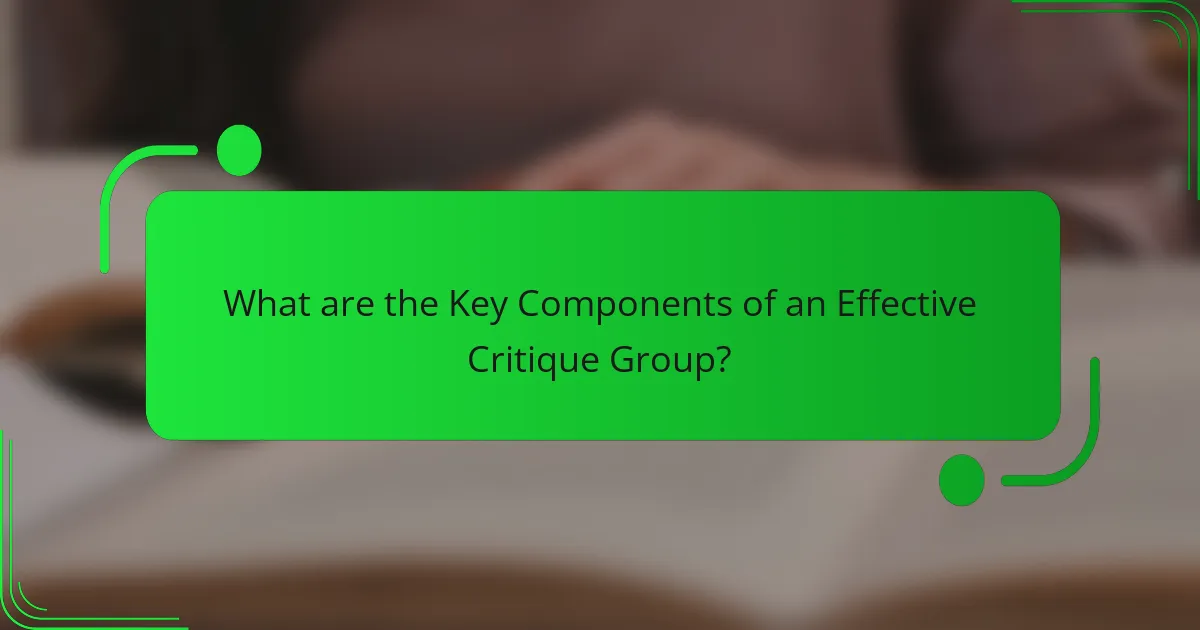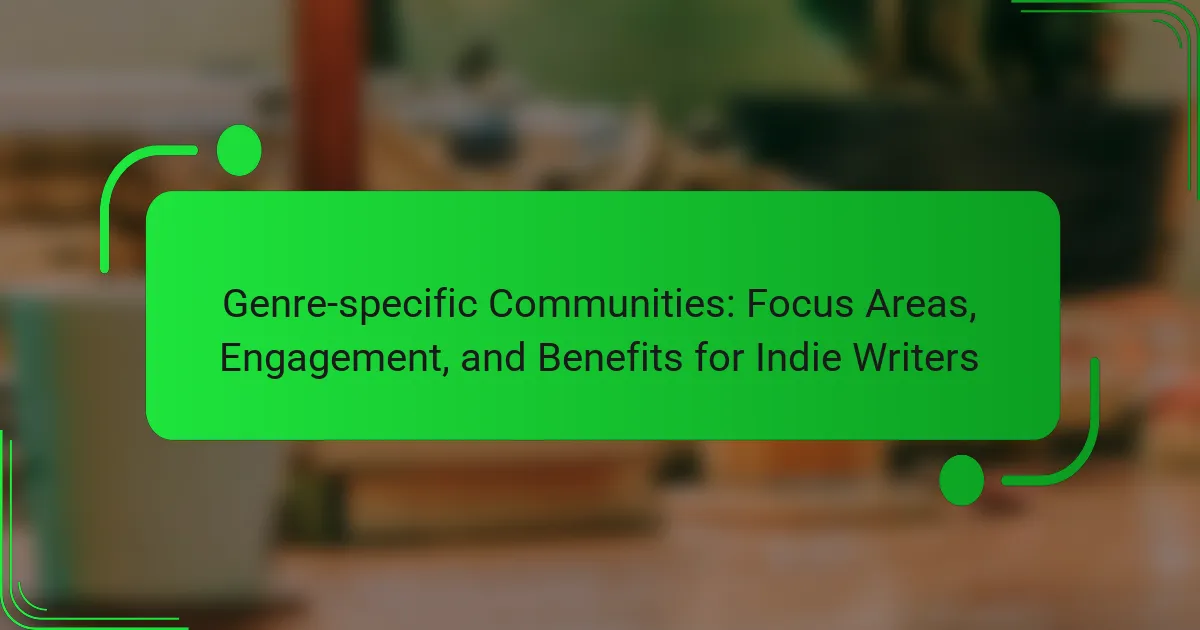Critique groups are vital for enhancing creativity and skill development through constructive feedback and collaboration. This article explores their importance in fostering diverse perspectives, outlines effective group structures, and offers guidance on finding the right fit for your creative goals. Additionally, it addresses common challenges and provides strategies for maximizing your critique group experience.

Why are Critique Groups Essential for Creative Development?
Critique groups are essential for creative development as they provide constructive feedback, foster collaboration, and enhance skills. Engaging with peers promotes diverse perspectives, which can lead to improved work quality. These groups often create a supportive environment that encourages risk-taking and innovation. Finding the right fit is crucial; members should share similar goals and values to maximize the benefits of participation.
What Benefits Do Critique Groups Offer to Participants?
Critique groups provide valuable feedback, accountability, and networking opportunities for participants. They enhance skills through constructive criticism, foster collaboration, and encourage diverse perspectives. Participants benefit from structured support, which can significantly improve their work quality and creative confidence.
How Do Critique Groups Foster Accountability and Motivation?
Critique groups foster accountability and motivation by creating a supportive environment where members share feedback and set goals. Regular meetings encourage members to present their work, receive constructive criticism, and commit to deadlines. This structure enhances individual responsibility and drives progress. Additionally, the collective nature of critique groups builds camaraderie, making members more likely to stay motivated and engaged in their creative pursuits.

What are the Key Components of an Effective Critique Group?
An effective critique group includes trust, constructive feedback, diverse perspectives, and clear goals. Trust fosters open communication, allowing members to share their work without fear. Constructive feedback focuses on improvement rather than criticism, enhancing the creative process. Diverse perspectives bring varied insights, enriching discussions and broadening understanding. Clear goals ensure that all members are aligned and working towards a common purpose, maximizing the group’s effectiveness.
How Should Group Structure and Size Influence Dynamics?
Group structure and size significantly influence dynamics by affecting communication, decision-making, and overall effectiveness. Smaller groups tend to enhance participation and cohesion, while larger groups can provide diverse perspectives but may face challenges in coordination.
Optimal group size typically ranges from five to seven members, allowing for meaningful interaction without overwhelming complexity. A well-defined structure clarifies roles and responsibilities, promoting accountability and streamlined processes.
For example, in critique groups, a balanced mix of roles—facilitator, note-taker, and participant—can enhance productivity. As a result, understanding these dynamics is crucial for selecting the right group composition and structure to achieve desired outcomes.
What Roles Should Members Take on Within a Critique Group?
Members within a critique group should take on specific roles to enhance productivity and feedback quality. Key roles include facilitator, critic, supporter, and timekeeper.
The facilitator guides discussions and ensures everyone participates. The critic provides honest, constructive feedback, focusing on strengths and weaknesses. The supporter encourages members and highlights positive aspects of the work. The timekeeper manages the session duration, ensuring discussions remain focused and productive.
These roles help create a balanced environment where all members contribute effectively, leading to improved outcomes for everyone’s work.
Which Communication Styles Enhance Feedback Quality?
Effective communication styles that enhance feedback quality include active listening, constructive criticism, and open-ended questioning. These styles foster a supportive environment for critique groups, promoting deeper engagement and understanding. Active listening encourages participants to fully comprehend feedback before responding. Constructive criticism focuses on specific behaviors rather than personal attributes, making it easier to accept. Open-ended questioning invites dialogue, allowing for clarification and exploration of ideas. Together, these styles create a framework that improves the overall quality of feedback in critique settings.

How Can You Identify the Right Critique Group for Your Needs?
To identify the right critique group for your needs, consider your specific goals and preferences. Evaluate the group’s focus, member experience, and feedback style. Look for a supportive environment that fosters constructive criticism and aligns with your creative aspirations. Engage with potential groups to assess compatibility before committing.
What Criteria Should You Consider When Choosing a Group?
When choosing a critique group, consider the group’s focus, member expertise, and meeting structure. A clear focus ensures that feedback is relevant to your work. Member expertise should align with your needs for constructive criticism. Meeting structure impacts how effectively discussions are facilitated and time is managed.
How Do Regional Differences Affect Critique Group Dynamics?
Regional differences significantly influence critique group dynamics by shaping communication styles, feedback preferences, and cultural norms. These variations can affect the overall effectiveness of group interactions. For instance, in some cultures, direct criticism may be valued, while in others, a more indirect approach is preferred. Understanding these differences is crucial for fostering productive discussions and ensuring all members feel comfortable sharing their perspectives. Additionally, regional backgrounds can impact the types of work being critiqued, as local trends and practices may vary.
What Tools and Platforms Facilitate Online Critique Groups?
Various tools and platforms enhance the functionality of online critique groups. Popular options include Google Docs for collaborative editing, Slack for communication, and Zoom for virtual meetings. These platforms facilitate real-time feedback and discussion among members. Additionally, specialized tools like Critique Circle and Scribophile offer structured environments tailored for writers seeking peer reviews. Each platform provides unique attributes that cater to different group needs, such as document sharing, chat features, and project management capabilities.

What Common Challenges Do Critique Groups Face?
Critique groups often face challenges such as differing skill levels, lack of commitment, and unclear objectives. These issues can hinder effective feedback and collaboration. Additionally, members may struggle with balancing constructive criticism and personal feelings, leading to tension. Establishing clear guidelines and fostering a supportive environment can mitigate these challenges.
How Can Conflict be Managed Within a Critique Group?
Conflict within a critique group can be managed effectively through open communication and established guidelines. Encouraging honesty while fostering respect helps maintain a constructive environment. Setting clear expectations for feedback can minimize misunderstandings and personal conflicts. Regular check-ins can also help address issues before they escalate.
What Strategies Help Overcome Feedback Resistance?
Engaging in critique groups can effectively overcome feedback resistance by fostering a supportive environment. Establish clear communication norms to encourage openness. Create structured sessions where feedback is specific and actionable. Additionally, select group members who share similar goals to enhance trust and receptivity.

How to Maximize Your Experience in a Critique Group?
To maximize your experience in a critique group, actively engage with feedback and contribute constructively. Establish clear goals for what you want to achieve, such as improving writing skills or gaining diverse perspectives.
Foster a supportive atmosphere by respecting differing opinions and encouraging open dialogue. Regularly share your work and be open to receiving criticism, as this enhances growth.
Participate consistently to build trust and rapport with group members, which can lead to more insightful critiques. Lastly, evaluate the group’s dynamics periodically to ensure it remains a good fit for your evolving needs.
What Best Practices Should Members Follow for Constructive Feedback?
Members should focus on being specific, constructive, and respectful when providing feedback. Clear communication fosters a positive environment and encourages growth.
1. Be specific: Highlight particular aspects of the work to address, avoiding vague comments.
2. Offer constructive criticism: Frame feedback in a way that suggests improvements rather than just pointing out flaws.
3. Balance positive and negative: Include praise alongside critiques to maintain motivation.
4. Respectful tone: Use language that is supportive and empathetic, promoting an open dialogue.
5. Encourage questions: Allow the recipient to seek clarification, fostering understanding and collaboration.
6. Follow up: Check in after feedback is given to discuss progress and further improvements.
Which Mistakes Should You Avoid in a Critique Group Setting?
To avoid mistakes in a critique group, focus on clear communication and respect for differing opinions. Common errors include dominating discussions, dismissing feedback, and failing to prepare. Encourage constructive criticism and actively listen to all members. Establish guidelines to foster a supportive environment.
How Can You Leverage Critique Group Insights for Personal Growth?
Critique groups provide valuable insights that can significantly enhance personal growth. Engaging with diverse perspectives helps identify strengths and weaknesses in your work. These insights foster self-awareness, encourage accountability, and promote skill development. By actively participating in discussions, you refine your critical thinking and adaptability, crucial traits for personal and professional advancement.



